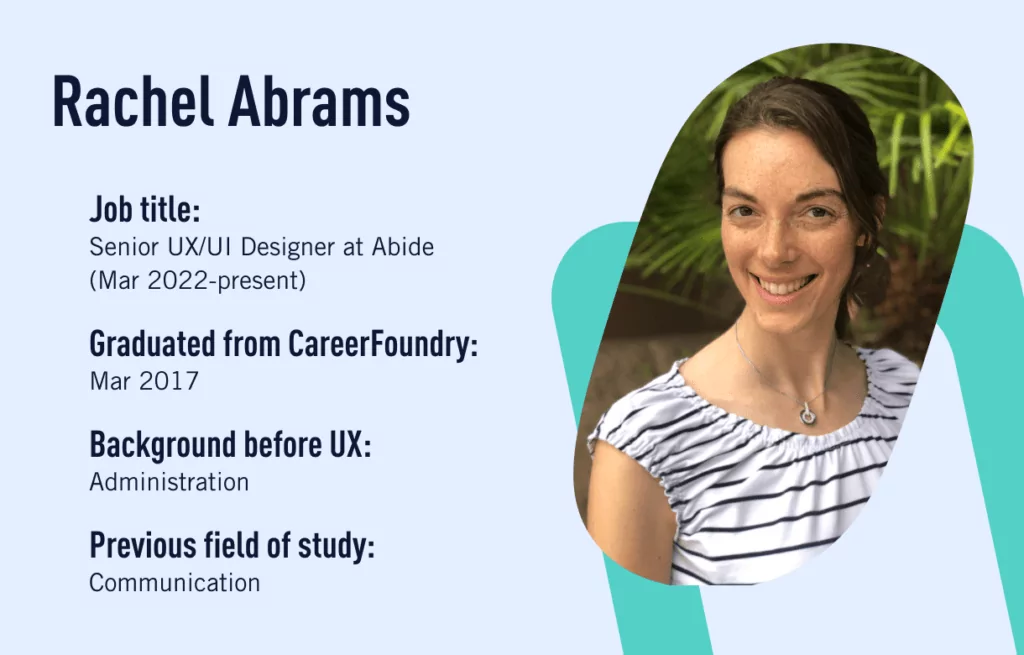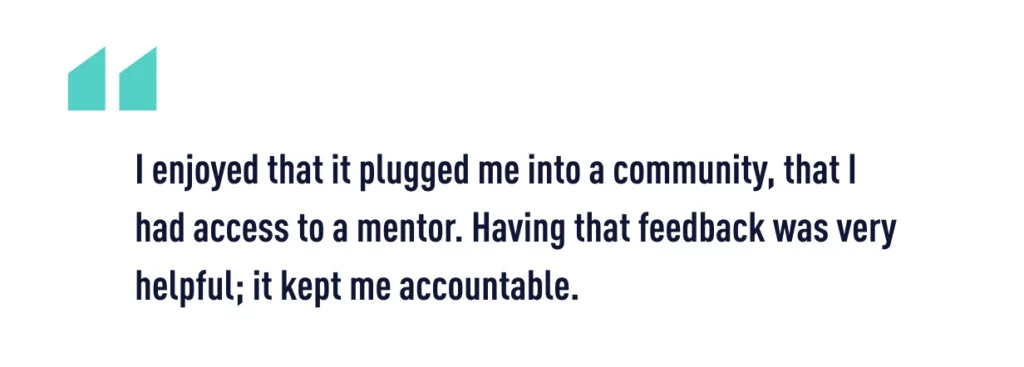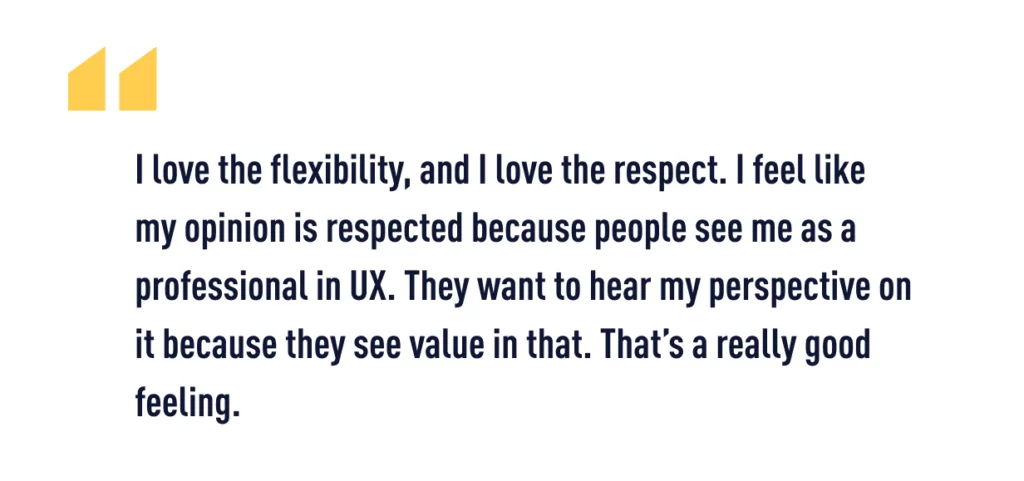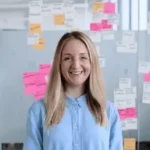
When we catch up with CareerFoundry graduate Rachel Abrams, she is positively bursting with energy and enthusiasm for her new career. Working as a UX designer for a major healthcare company, she has finally discovered her passion. However, there was a time when she hadn’t even heard of user experience (UX) design.
Here, Rachel shares her fascinating story of how she made a career change from admin, completed the UX Design Program with CareerFoundry, landed her dream job, and made some lifelong friendships along the way.
What were you doing before you took the CareerFoundry UX course?
I was working in admin, basically trying to find what I was passionate about. I had graduated with a Bachelor’s in communication a while back, but I never quite got into the field. I was just always kind of looking for that niche that I wanted to go into. I knew I wanted to make a career change from admin though as I was just doing that in the meantime.
What led you to UX design?
I have a friend who works in tech—he’d been a product manager at several tech companies—and he recognized the potential in me to do UX and UI (user interface) design. I didn’t know it was a thing, I’d never even heard of it before! But he told me he thought I’d be good at designing apps. I was like, that sounds really hard; I sort of ignored it at first.
Recommended reading: What’s the difference between UX and UI design?
Then a year went by and I looked into it again. I did some research online and tried to teach myself because I wanted to save money, but I ended up getting really overwhelmed by all the resources out there and how to curate them.
I thought to myself, I can either try to teach myself and put together my own curriculum (double the work!) or I can go to something that’s already curated and led, allowing me to focus on the skills I really wanted to learn—UX design. So I decided to go with a structured course.
All the traits and skills listed for a UX designer were exactly the things that I had exhibited throughout the years. I had done side projects as well as admin, mainly graphic design work—branding, logo design, things like that—I even had my own business for a little while. The creativity and the cursory Photoshop skills were already there, but I needed to learn the techniques and processes for this specific field. Then of course I saw the salary…it’s been a $15k bump from what I was earning before!
What do you think your friend saw in you that was particularly suited to UX?
Two things. I always exhibited creativity; I would apply that artistic eye to everything I did. But also the curiosity and problem-solving side of me; I am always looking for solutions to problems, whether technological or process-oriented, I was always thinking about that.
What did you enjoy most about the UX Design Program?
The project-based structure was really useful, having to do the assignments step by step and being able to submit them, get feedback and then re-submit.

When I was looking at moving to Phoenix, I got in touch with another CareerFoundry student who lived there and I ended up staying with her when I went to Phoenix for a conference. We’ve remained friends and have seen each other through the CareerFoundry journey—we even started a new job on the same day! It’s interesting to note the connections you can make through CareerFoundry, and just how beneficial it is to have that community.
What were your next steps after finishing the course?
When I graduated, I wasn’t sure where I wanted to live. At first I just kept working on my portfolio and looking for volunteer work. I didn’t find anything right away, but I kept working on my portfolio and I got involved with Code For Social Good. Danielle Sander (one of CareerFoundry’s career specialists) hooked me up with them, which was really great as it meant I could continue practicing what I’d learned and keep building my portfolio.
I also started introducing some of the UX techniques I’d learned into my day job. Even though I was still working in admin, things like personas were very applicable to what we were doing at the time. Our company was going through organizational change and they were looking closely at how customers were treated.
We were assigned to work on personas, so I led my team in creating the personas! We were also using a certain software, a meeting planning software, but they had a horrible UI and UX—and they knew it! They just so happened to be in the process of redesigning their software and the entire user experience.
Now, at that point, I was open with my boss about the fact that I was looking to change careers from administration, and she was really supportive of me. I ended up connecting with the CEO of the aforementioned software company and offering my UX services to them. I transitioned by cutting down to part-time at my day job in admin and doing 10 hours a week on contract at the software company.
That’s very proactive of you! It’s important to put your newfound skills into practice where possible. What happened next?
I continued working with the software company about a month after finishing my current job, then I decided to move to Phoenix while still freelancing with them. I came to Phoenix, had an interview the next day, and got a job three weeks later with an agency.
They’re a digital promotions agency doing sweepstakes and instant win games, all for major fortune 100 and fortune 500 companies. It was a great opportunity to work with some big names and get some agency experience, learning their processes.
It was a 3 month contract to hire, so during that time, I was still working with CareerFoundry’s career specialists. While working at the agency, I was keeping my eye out for other opportunities. Agency work wasn’t so fulfilling for me; I really wanted to get into healthcare tech.
Then this awesome opportunity came up at Banner Health, the largest healthcare provider in Arizona. They were building out a whole digital team to focus on new technologies, applications and voice applications with Alexa and Google.
It sounds like you were juggling a lot during this time. What was the biggest learning from the job search period?
In moving from Boston to Phoenix, and from my time at CareerFoundry, I learned how important it is to network. So I used Slack to connect with local design channels in Phoenix and I met some people through that. I had also met some people in person at a design conference. We kept in touch on LinkedIn and Slack, and I saw this Banner Health job posting on Slack.
I went on LinkedIn and looked the guy up, and it turns out we had a connection from the design conference. I asked for an introduction, connected directly with the hiring manager, and sent my application. They hired me the day after the interview!
Did you feel job-ready when you graduated from CareerFoundry?
I felt I was job-ready, but I had a hard time selling that to employers. I really saw the importance of continuing with projects after the course. Employers wanted to see that versatility, the depth in portfolio—not just one project. They also really want to see that you’ve got experience working with developers.
Did you feel the need to learn to code?
I had some experience with HTML and had skimmed JavaScript; I understand the concept of coding but never spent the time learning to code. It’s not what I wanted to be doing. I heard a lot after I graduated about designers needing to code, and saw lots of job descriptions asking for UX designers who could code.
It was discouraging to see that, but at the same time, I said: OK, these jobs aren’t for me. I was looking for a UX position where I didn’t have to code. There are plenty of tools out there that allow you to do what you need to do and to prototype without coding, so if they’re asking for someone who can code and prototype, they probably don’t know what they’re looking for.
I didn’t want to step into a position where I was the one leading the charge for UX. I’m new to this, and don’t want to be fighting an uphill battle from the start. I want to work with other UX designers who can mentor me and help me grow.
Does your current role fulfill this?
So I’m currently working on a brand new digital experience team at Banner Health, a team of three. It’s a very established company so they’re heavily process-oriented, and UX is new to the company. The beautiful thing about this position is that their executive team has put together this digital experience team that functions outside of their usual structure and processes.
They have a business analyst, an entire dev team, and the business analyst manages relationships between all the different departments. Any potential clashes or any resistance to the way we’re doing things can be managed by this designated person, and it’s great that they’ve already got these things in place.
What are the top 3 aspects of your new career?
The best thing about working for Banner is that it’s in the healthcare sector. I feel that the work I’m doing is going to make a real difference to people’s lives. All my life I’ve been the tech expert in my family, working with different generations. I hate seeing people feel like tech is against them, or seeing them get frustrated, feeling like they can’t do the things that other people can do, or that younger generations can do. To me, it’s important that tech be understandable and usable—not something that feels threatening. That’s why I got into UX: to do something about it!
I see the healthcare industry as having the greatest potential for making real-world impact and improvements, and it has the greatest need for improvement. For so long, healthcare hasn’t been focused on the user; it was more like, we have expert services and you need us. Where else are you going to go?
Now they’re in a different position, with the likes of Google and Amazon starting to provide healthcare too. Is it the best option? Probably not. Is it easier? Yes. Rather than people running to an easier solution and perhaps getting lesser care, I would rather they opt for the best quality care but still get a great user experience.
What else do I love about my new career? I get to use my skills to their fullest. I get to pick what I’m interested in and go forward with that. There’s some usability research in there too, it’s well-rounded.

What advice would you give to anyone considering a dramatic career change into UX? What do you think is important to know about career changes for administrative assistants?
My advice would be: trust the process! At first, it’s new and you’re going to feel like you can’t do it. There’ll be times when you feel like it’s too much. You’re supposed to feel like that at first because it’s new! Trust the process that the course takes you through, and see it through.
If you’re not decided yet on what course to take, the earlier you pick something and stick with it, the deeper you’ll go with the learning. It’s very different to, say, a designer going into UX. If you’re coming in from an academic perspective, or a psychology background or something like that, you might be used to the learning process.
UX is very much a team-oriented, collaborative design process. This approach is so necessary because we cannot get inside other people’s heads; we cannot walk in other people’s shoes unless we talk with them and interact with them about what we’re designing in the process. I found that learning to have that empathy was so freeing to me and my personal growth, I started to apply that same perspective to many areas of my life.
And what would be your advice to anyone just starting out in the industry?
I’d say be willing to take small jobs here and there, be willing to take something that perhaps isn’t your ideal fit, just for the experience of it. That might lead to that job that you really want.
I once saw a post on LinkedIn advising people not to take “a wireframing monkey job”, but at first you are going to be taking orders! People are going to be saying we need this, we need that. It’s healthy to humble yourself; you may think you can do more than that, and maybe you can, but when you’re just starting out, it’s valuable to take those orders.
Do it as they’ve asked for it but don’t be afraid to suggest other ways either. Once you’ve got that down and you’ve got that confidence, you’ve shown what you can do, and that’s when you’re prepared.
Luck is when preparation meets opportunity. Keep preparing, and be diligent in what you’re doing. When the opportunity comes along, you will recognize it and it will recognize you.
Where do you see yourself 5 years from now?
I would say, leading a design team. Right now, I’m interested in just getting better at what I do. Perhaps I can see myself moving up to a UX strategist position, then maybe later on down the road, maybe even ten years later, maybe running my own consulting practice. Right now, I just want to grow and make an impact in this industry.
Thanks for sharing your story with us, Rachel!
If you’d like a step-by-step intro to find out if a career in design, development, data, digital marketing, or product management is right for you, sign up here for a free short course in the field of your choice.
If you’d like to speak to an expert program advisor for free about how you can get a new job in tech like Rachel, connect with us here.
Curious to know more about career changes for administrative assistants? Check out this success story from Alex who made the transition from business administration to UX design.
Update: Since talking to Rachel for this article originally, she’s gone from strength to strength in her design career and is now a senior UX/UI designer at Abide. Congrats!
